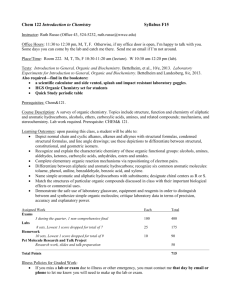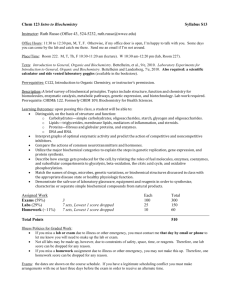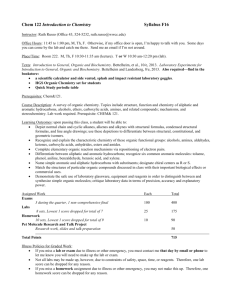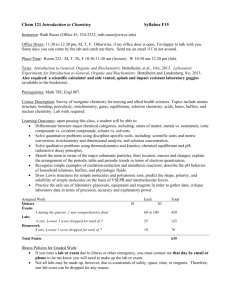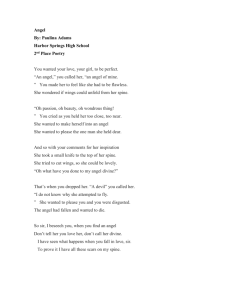View Syllabus - Walla Walla Community College
advertisement
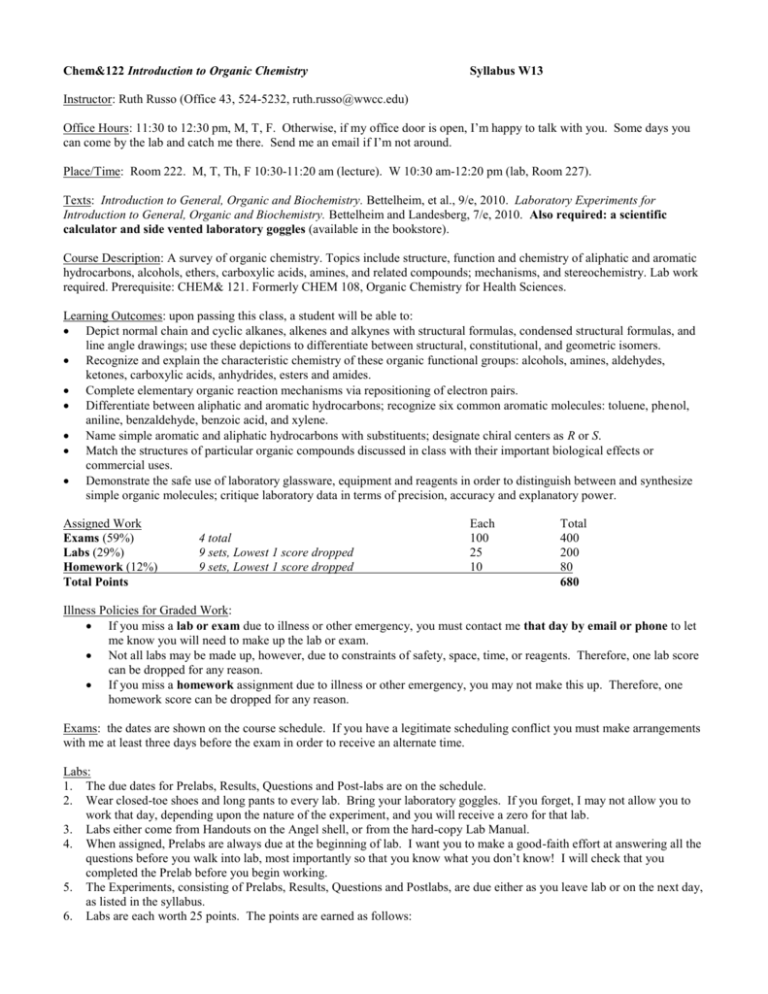
Chem&122 Introduction to Organic Chemistry Syllabus W13 Instructor: Ruth Russo (Office 43, 524-5232, ruth.russo@wwcc.edu) Office Hours: 11:30 to 12:30 pm, M, T, F. Otherwise, if my office door is open, I’m happy to talk with you. Some days you can come by the lab and catch me there. Send me an email if I’m not around. Place/Time: Room 222. M, T, Th, F 10:30-11:20 am (lecture). W 10:30 am-12:20 pm (lab, Room 227). Texts: Introduction to General, Organic and Biochemistry. Bettelheim, et al., 9/e, 2010. Laboratory Experiments for Introduction to General, Organic and Biochemistry. Bettelheim and Landesberg, 7/e, 2010. Also required: a scientific calculator and side vented laboratory goggles (available in the bookstore). Course Description: A survey of organic chemistry. Topics include structure, function and chemistry of aliphatic and aromatic hydrocarbons, alcohols, ethers, carboxylic acids, amines, and related compounds; mechanisms, and stereochemistry. Lab work required. Prerequisite: CHEM& 121. Formerly CHEM 108, Organic Chemistry for Health Sciences. Learning Outcomes: upon passing this class, a student will be able to: Depict normal chain and cyclic alkanes, alkenes and alkynes with structural formulas, condensed structural formulas, and line angle drawings; use these depictions to differentiate between structural, constitutional, and geometric isomers. Recognize and explain the characteristic chemistry of these organic functional groups: alcohols, amines, aldehydes, ketones, carboxylic acids, anhydrides, esters and amides. Complete elementary organic reaction mechanisms via repositioning of electron pairs. Differentiate between aliphatic and aromatic hydrocarbons; recognize six common aromatic molecules: toluene, phenol, aniline, benzaldehyde, benzoic acid, and xylene. Name simple aromatic and aliphatic hydrocarbons with substituents; designate chiral centers as R or S. Match the structures of particular organic compounds discussed in class with their important biological effects or commercial uses. Demonstrate the safe use of laboratory glassware, equipment and reagents in order to distinguish between and synthesize simple organic molecules; critique laboratory data in terms of precision, accuracy and explanatory power. Assigned Work Exams (59%) Labs (29%) Homework (12%) Total Points 4 total 9 sets, Lowest 1 score dropped 9 sets, Lowest 1 score dropped Each 100 25 10 Total 400 200 80 680 Illness Policies for Graded Work: If you miss a lab or exam due to illness or other emergency, you must contact me that day by email or phone to let me know you will need to make up the lab or exam. Not all labs may be made up, however, due to constraints of safety, space, time, or reagents. Therefore, one lab score can be dropped for any reason. If you miss a homework assignment due to illness or other emergency, you may not make this up. Therefore, one homework score can be dropped for any reason. Exams: the dates are shown on the course schedule. If you have a legitimate scheduling conflict you must make arrangements with me at least three days before the exam in order to receive an alternate time. Labs: 1. The due dates for Prelabs, Results, Questions and Post-labs are on the schedule. 2. Wear closed-toe shoes and long pants to every lab. Bring your laboratory goggles. If you forget, I may not allow you to work that day, depending upon the nature of the experiment, and you will receive a zero for that lab. 3. Labs either come from Handouts on the Angel shell, or from the hard-copy Lab Manual. 4. When assigned, Prelabs are always due at the beginning of lab. I want you to make a good-faith effort at answering all the questions before you walk into lab, most importantly so that you know what you don’t know! I will check that you completed the Prelab before you begin working. 5. The Experiments, consisting of Prelabs, Results, Questions and Postlabs, are due either as you leave lab or on the next day, as listed in the syllabus. 6. Labs are each worth 25 points. The points are earned as follows: 7. a. Prelab done prior to lab (5 points) b. Attendance (5 points) c. Clean-up and esprit-de-corps (5 points) d. Content of Prelabs, Results, Questions and Postlabs (10 points) The Pet Molecule talks also count as a lab. These will be delivered 3/1/12. More on that assignment later. Graded Homework: the homework assignments (10 points each) are due as listed on the schedule. They consist of two parts: ungraded practice problems and graded problems. 1. Ungraded Practice Problems (5 points). I want to see evidence that you have attempted the problems that I suggest from the end-of-chapter problems. Most of these have answers in the back of the book, but I want to see your sketches, attempts, calculations, etc. These can be “sloppy copies.” Staple these to the Graded Problems. 2. Graded Problems (5 points): these will be end-of-chapter problems (or problems that I make up) that don’t have answers in the back of the book. These are problems that show me whether or not you understand concepts, calculations, and information prior to the exams. 3. Homework assignments will be posted on the Angel shell for each chapter, found under the “lessons” tab. Accommodations: To request accommodations related to a disability, contact Claudia Angus, Ph.D., Coordinator of Disability Support Services, at 527-4262 or email claudia.angus@wwcc.edu. Accommodations can include note takers, extra time on exams, etc. Etiquette: Please be courteous to your fellow students and me. 1) Please do not answer your cell phone or text during class. If you absolutely need to be in contact for family or work reasons, set the phone to vibrate and take the call outside the door. 2) Please do not be consistently late for class. If you have transportation issues, let me know. 3) Please do your best for your lab partner and everyone else in the lab. You are mutually responsible for the success of the lab pair, and the safety of everyone relies upon you! Grading Scale: the grading scale below depicts the highest “floors” for each category that I predict. For example, if you have a 93% on all work, you would receive an A, while someone with 92% on all work would receive an A-. I reserve the right to lower the floors at the end of the quarter based upon both student and instructor performance relative to years past. In this case, the 92% might merit an A if I have designed especially difficult exams, e.g. Percent Letter Grade 4 point scale 93-100 A 4.0 90-92.9 A3.7 87-89.9 B+ 3.3 83-86.9 B 3 80-82.9 B2.7 77-79.9 C+ 2.3 73-76.9 C 2 70-72.9 C1.7 67-69.9 D+ 1.3 60-66.9 D 1 0-59.9 F 0 After week 2, your grades will be available to you in real time on the Angel shell. Prior to the end of week 2, there are not enough data in the gradebook for the percentage to make sense. Withdrawal Policy You may withdraw from the course without a grade through Feb 15. After this date, you will receive a grade whether or not you continue to attend class. Extra Help The most successful chemistry students are the ones who plug away with a determined work ethic. Asking for help early and often is a wise and strategic move. Come see me often. I love students who ask a lot of questions. Dr. Laura Schueller in the Tutoring Center is also an excellent resource (in addition to being brilliant, she brings treats to the tutoring center on Fridays). The Tutoring Center hires a chemistry-specialist tutor early in the quarter, so introduce yourself and visit him or her often. You can also direct questions to Keenan Failing in the Stockroom, especially if it deals with aqueous chemistry. We are all here to help you succeed. Academic Honesty: cheating and/or plagiarism will incur a penalty ranging from F on the assignment, to failing the course or being expelled from the college. See www.wwcc.edu Current StudentsStudent ResourcesStudent PoliciesStudent Code of Conduct. Schedule: we shall be following the attached calendar. It may be modified due to circumstances beyond my control. My suggestion is to carry it in your backback or notebook and refer to it weekly, to plan your studying, and daily, to see what is due tomorrow. The Angel Shell for our class: we have an online “shell” in the Angel system. This serves three major functions: 1. I post all my handouts, power points, and keys (the correct answers for homeworks, labs, and tests) on the Angel shell for our classroom. Some students like to print out the power points for each chapter to take notes upon, and ALL students ought to look at the keys before exams. 2. You can look at your grades as soon as I enter in your points for each assignment. It is pretty meaningless until Week 3 but then it is quite useful. 3. I prefer to have all email communication done through the Angel Shell, since it automatically creates an email list for our class. If I need to make corrections, additions, announcements, etc., I will send these out via the Angel email. Most importantly, if I get SICK and can’t come in, I will try to give you some advanced warning from home via this list. Please plan to check the site once a day during the term OR set up the Angel email to forward to your preferred email or phone. See below for directions. GETTING STARTED IN ANGEL ONLINE Logging On Two Ways Single Sign-On MyWWCC Skip Announcements Your Personal Page/QuickLinks/Angel/WAOL Online Class/Will take you to your home page/Click on our class Via URL http://angel.wwcc.edu (Nota Bene: no “www”) Your username: 814. . . ./Your password: last five letters of last name, or full last name (No apostrophes, no hyphens) Will take you to your home page/Click on our class System Check There is a system check box on the main Course page. You need to click on any items that have red check marks and enable or add these components under your preferences. Pop-ups, especially, need to be enabled. Lessons Course content, like handouts and homework solutions, will live here. “Lessons” is one of the main header tabs. Communicate To have your Angel mail forward to an email address that you do check frequently: Communicate (one of the main header tabs) Course Mail View Inbox Preferences (upper right) Forward to Internet email Please select “forward mail and keep as new”/Enter your email/Save button @ bottom of page Grades Your grades, both overall and by category, are available here as soon as I enter them. Grades (one of the main header tabs) Report Settings Category: select “grades”/Your name should show as “user”/Select RUN in lower right THE SCHEDULE CHEM&122 WINTER 2013 MONDAY LECTURE TUESDAY LECTURE Week 1: 12/31-1/4 WEDNESDAY LAB THURS LECTURE FRIDAY LECTURE Ch.10: Organic Chemistry. Meet in lecture hall. Ch.10: Organic Chemistry Ch.11: Alkanes. Due: HW Ch. 10. Expt. 21:Organic Ch.12: Alkenes, Week 2: 1/7Ch.11: Alkanes. Ch.11: Alkanes Ch.11: Alkanes. Structure I. Bring models. Alkynes. Due: 1/11 Due: Expt. 21 Due: Prelab. HW Ch. 11 Week 3: 1/14-1/18 Ch.12: Alkenes, Ch.12: Alkenes, Alkynes. Alkynes. Week 4: 1/21-1/25 MLK Holiday Ch. 13: Benzene and Derivatives. Week 5: 1/28-2/1 Ch. 14: Alcohols and Ethers. Due: HW Ch. 13. Ch. 14: Alcohols and Ethers Ch. 15: Ch. 15: Chirality. Bring Week 6: 2/4- Chirality. Due: molecular 2/8 Homework Ch. model set to 14. class. Expt. 22:Organic Structure II. Bring models. Due: Prelab. Review: Ch. 10-12. Due: HW Ch. 12 AND Expt. 22. Exam I: Ch. 10-12. Expt. 23: Chromatography of Plant Pigments. Due: Prelab. Ch. 13: Benzene and Derivatives. Due: Expt. 23. Ch. 13: Benzene and Derivatives. Expt. 24: Identification of Hydrocarbons. Due: Prelab. Ch. 14: Alcohols and Ethers. Due: Expt. 24. Ch. 14: Alcohols and Ethers No lab today. Review: Ch. 13-15. There are NO problems due for Ch. 15. Exam II: Ch. 13-15. Reading Day: Ch. 16 and 17 Ch. 17: Ch. 16: Amines. Aldehydes and Due: Expt. 28 Ketones. Due: Ch. 16 HW Week 7: 2/11-2/15 Ch. 16: Amines. Ch. 16: Amines. Expt. 28: Properties of Amines. Due: Prelab. Week 8: 2/18-2/22 President's Holiday Chapter 17: Aldehydes and Ketones. Handout: Salicylic Acid Standard Curve. Due: Prelab. Ch. 17: Aldehydes and Ketones. Due: Standard Curve Lab. Ch. 17: Aldehydes and Ketones Week 9: 2/25-3/1 Review: Ch. 16-17. Due: Ch. 17 HW Exam III: Ch. 16-17. Advising Day: No Lab Ch. 18: Carboxylic Acids. Ch. 18: Carboxylic Acids. Week 10: ¾3/8 Ch. 18: Carboxylic Acids. Pet Molecule Talks I. Due: HW Ch. 18. Expt. 30: Preparation of Aspirin. Due: Prelab. Pet Molecule Talks II. Due: Expt. 30. Ch. 19: Carboxylic Acid Anhydrides, Esters, Amides Expt. 27: Carboxylic Acids and Esters. Due: Prelab. Ch. 19: Carboxylic Acid Anhydrides, Esters, Amides. Due: Expt 27. Review of Ch 18-19. Due: Ch. 19 HW. Week 11: 3/11-3/15 Week 12: 3/18-3/22 Ch. 19: Ch. 19: Carboxylic Carboxylic Acid Acid Anhydrides, Anhydrides, Esters, Amides. Esters, Amides. Exam IV: 10:30-12:30
